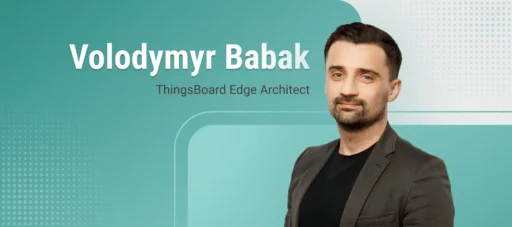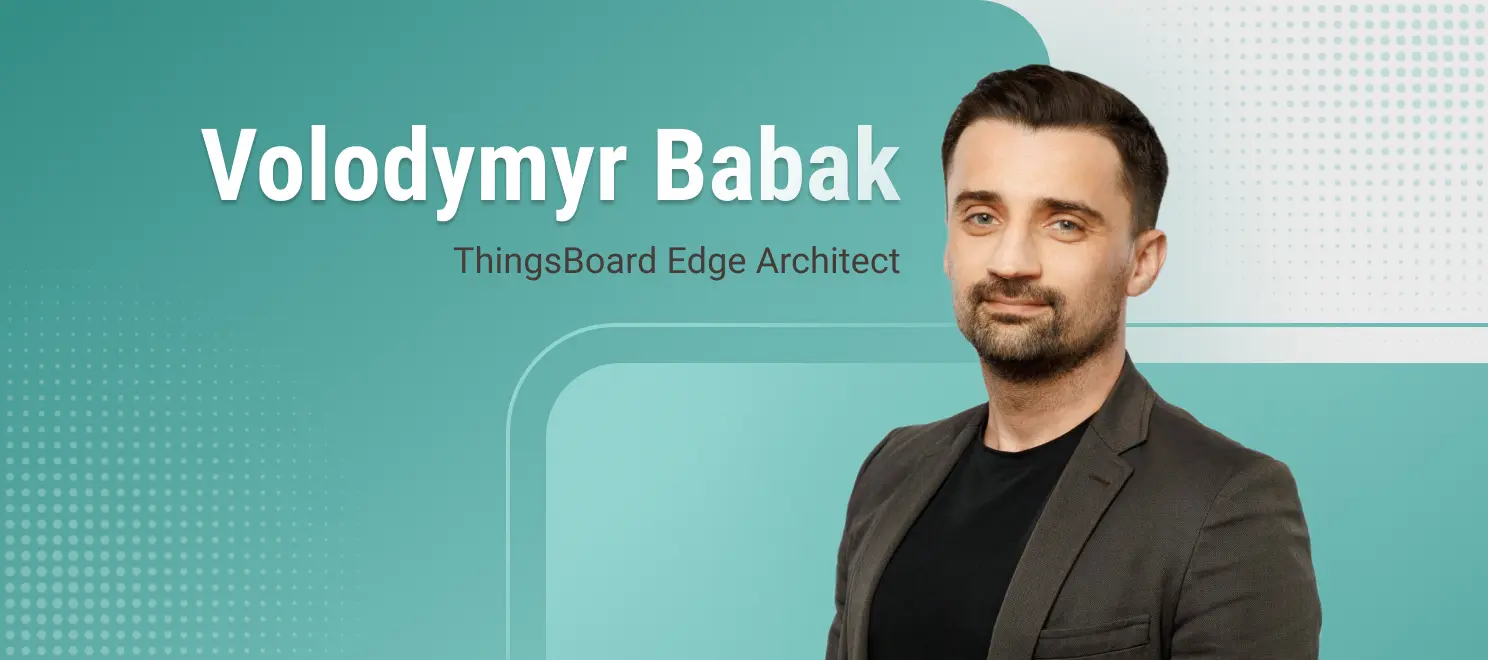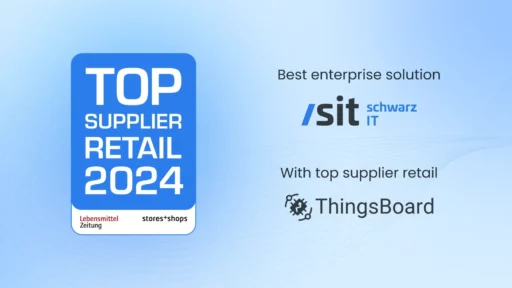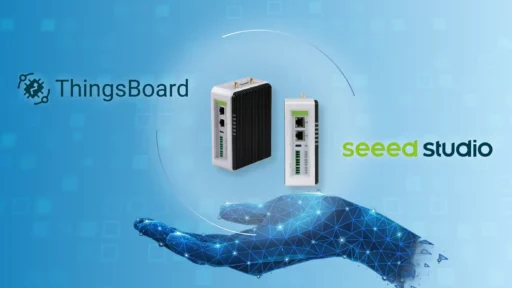Welcome back to Part 2 of our conversation with Volodymyr Babak – ThingsBoard Edge solution architect! In the Part 1 of this interview, we explored the origins of ThingsBoard Edge. Now, let’s shift our focus to the technical breakthroughs and what to expect in the future releases. Let’s get started!
Technical Breakthroughs
Q: What do you think is the one standout feature that makes Edge unique? A challenge that only Edge is capable of addressing?
A: I can think of a few, but if we talk about the one and only – it would be its ability to operate while disconnected from the Cloud. Edge can still trigger critical rules and automate responses in critical situations. And an honorable mention? It’s how Edge distributes the processing load across multiple locations, so you’re not relying on a single central server.
Q: What was the biggest technical challenge in designing ThingsBoard Edge?
A: The most remarkable feature turned out to be the toughest to design. We had to make sure Edge stays in sync with the Cloud and that it doesn’t just go dormant when the connection drops. We had to build special communication protocols to keep critical tasks running and then syncing them up smoothly once connectivity is restored. Getting that balance right was a real challenge, but it was crucial to making Edge reliable in real-world deployments.
Q: Speaking of challenges, what were the most unexpected obstacles during the development process?
A: We were surprised at how difficult it was to create compatible support for different Edge and Cloud versions. As it turned out, it was an unexpectedly complex task to make sure that everything worked smoothly despite the version combination. It took a lot of effort and extensive testing to get it right.
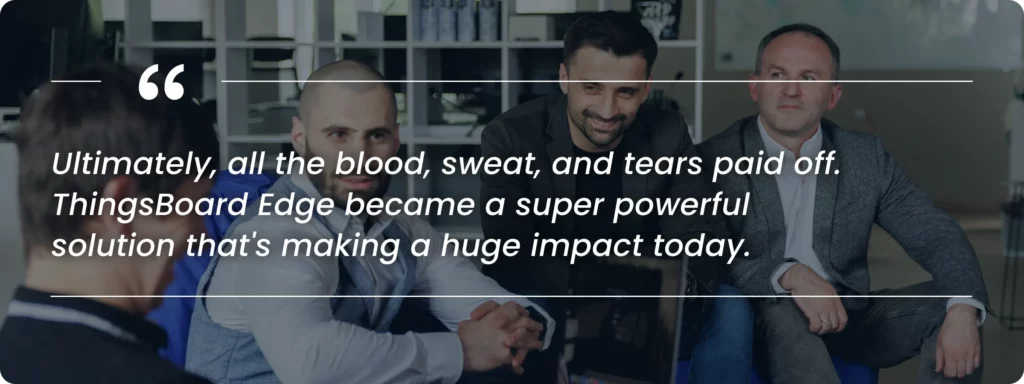
Q: What are the main challenges you see in the market?
A: The biggest challenge is obviously showing how edge computing can solve specific customer problems. It’s crucial to give real-world examples and demonstrate the direct advantages of edge solutions to help customers understand and adopt the technology effectively.
Q: Could you tell me about the major performance improvements in Edge? Also, how’d you come up with these ideas?
A: One of our significant optimizations was using Kafka to store uplink events from the Edge to the Cloud. We found that relying just on PostgreSQL led to performance issues when handling millions of events. Our decision to integrate Kafka was based on our deep understanding of different system architectures and their strengths. This approach really boosted data handling efficiency and scalability for ThingsBoard Edge.
Q: I’m curious to know how ThingsBoard Edge handles connectivity issues and offline mode?
A: In short, ThingsBoard Edge buffers uplink messages locally, allowing the system to continue functioning smoothly even when the network is down. This ensures operations keep going and data gets sent without a hitch once connectivity is back.
Q: How has the product evolved since its first release?
A: Since its initial release, we mainly focused on enhancing performance and ensuring smoother connectivity. Just like cars have gotten better over time with more powerful engines and reliable systems, we’ve been working to make our product better at handling large amounts of data and staying connected to the Cloud.
The Future of ThingsBoard Edge and Edge Computing
Q: What do you think are the most common misconceptions about edge computing in general and ThingsBoard Edge in particular?
A: Well, a lot of people think that edge computing is just about using IoT gateways or processing everything locally, but that’s not really the case. It’s more about balancing the Cloud and the Edge to optimize performance and efficiency.
As for ThingsBoard Edge, it’s often mistaken for ThingsBoard IoT Gateway (which is a Python-based software). But actually, ThingsBoard Edge is more than just a simple gateway. It’s a full-fledged computing platform with advanced data processing, local automation, and seamless cloud integration. It’s built to handle much more than just data forwarding.
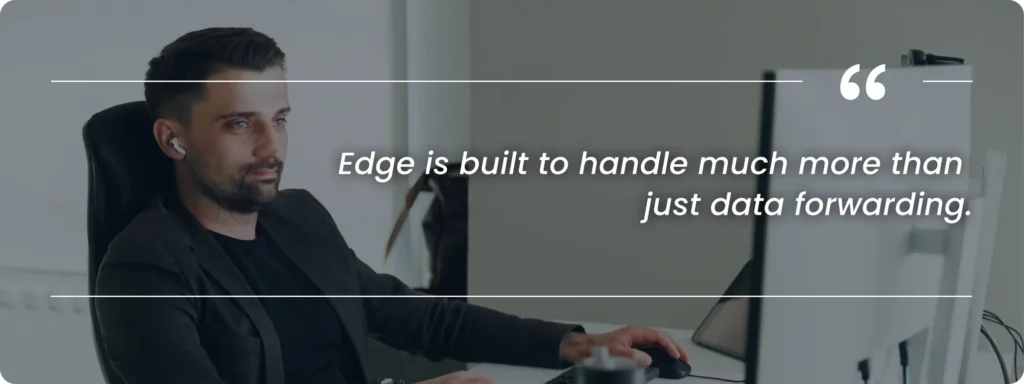
Q: Are there any plans to integrate AI/ML capabilities into ThingsBoard Edge?
A: Oh, absolutely! Everyone’s talking about AI/ML these days, and we’re no different. I think it’ll really enhance intelligent data analysis and provide advanced and efficient solutions for our users. But let’s keep a little secret about when to expect it.
Q: What can we expect from ThingsBoard Edge then? Any exciting features you’d like to share with us?
A: Definitely, yes! In the next release, we’re introducing a Remote Docker Agent, which will make managing edge deployments much more manageable. It’ll allow users to start, stop, and upgrade Edge instances remotely, removing the need for manual intervention.
Q: Wow, that sounds exciting! Will it simplify Edge management?
A: For sure! All the updates and configurations can be handled remotely. We believe that it will greatly improve the user’s experience in maintaining Edge devices, configurations, and updates! As the marketing experts say: “Coming soon!”
Q: I can’t wait to see it in person!
A: Me, too! (laughs)
Q: Where do you think the IoT industry is headed? What role will edge computing play in it?
A: In my opinion, we’re heading towards greater decentralization and real-time data processing. The number of edge devices and volume of transferred data is increasing not even every year – every month! The demand for computing power is also growing rapidly. I believe such an approach will be crucial in solving these issues. As you know, edge computing is designed to process data closer to its source and reduce latency and bandwidth usage. These features will support applications like autonomous vehicles and smart manufacturing, where real-time data processing is critical. Overall, edge computing will lead to new ideas and the ability to handle more work in the changing IoT world.
Q: Looking back on the path you have taken so far, is there anything you would like to change?
A: I’d like to say that I have no regrets. But in hindsight, we should’ve dedicated more time and resources to marketing strategies during the early stages of ThingsBoard Edge’s development. This would’ve helped us to introduce it to a broader audience, which would’ve accelerated its development even further. However, history knows no ‘ifs’, and we’ll keep working hard for our users!
The Final Word
Looking back, we see the person behind the Edge—his passion, dedication, and a path full of challenges, misfortunes, and victories. Volodymyr and his team brought something special to the industry, turning a simple idea into a powerful solution. As we celebrated the third anniversary of ThingsBoard Edge, we knew for sure: the journey of ThingsBoard Edge was just getting started.
Check out the new and improved ThingsBoard Edge and see what you can do with it today!
